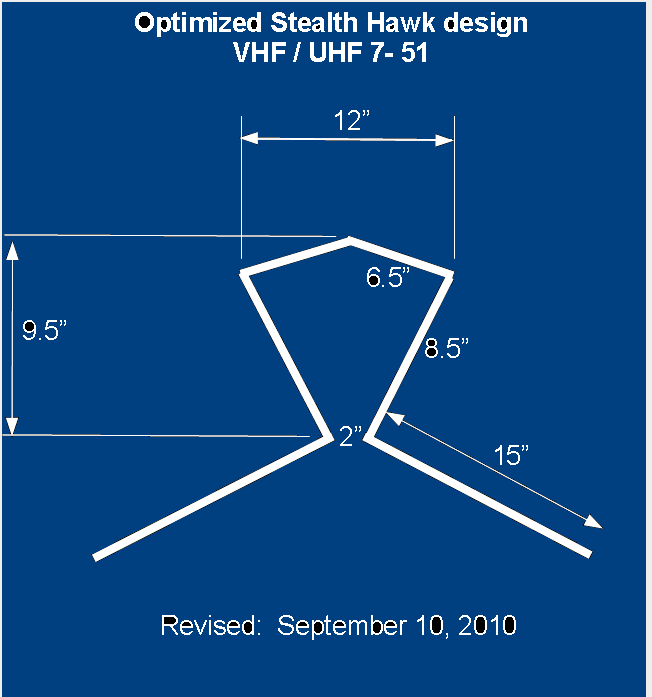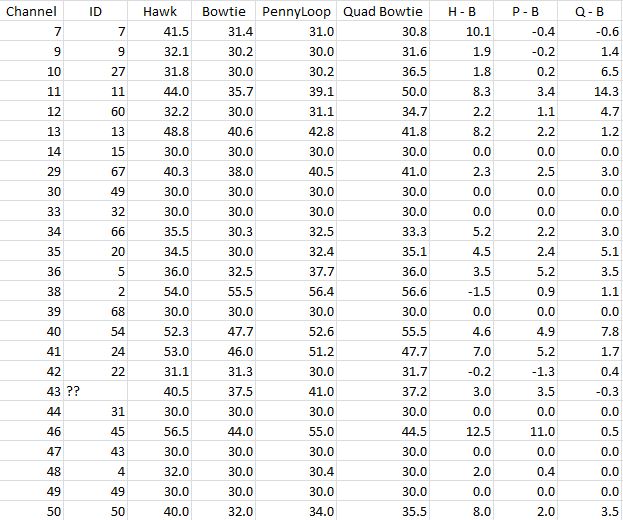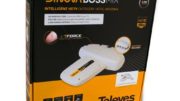The Stealth Hawk Antenna Gedanken (Thought) Evaluation
The Stealth Hawk Antenna is made from a single 60” (5’) long piece of wire. The design I used as my template was:

[VHF-UHF07-51]
The top section was 30″ long. Essentially, this is simply a 30″ full-wave loop, so the full wavelength is 30″, which is for about 394 MHz.
This is between channels 13 & 14, which are frequencies of 210 – 216 MHz and 14, 470 – 476 MHz respectively. This is a bit longer than that needed for the UHF frequencies starting at those of Ch 14. Also, 394 MHz is a bit closer to the beginning of channel 14 than the end of channel 13: Ch13/216 MHz : 394 MHz : Ch14/470 MHz, a difference of 90 MHz to the end of the Ch 13 band and only 76MHz to the beginning of the Ch 14 band.
The legs sticking out to the sides are a 30″ halfwave dipole so a full wave is 60″ or about 1.524 m. That gives us a frequency of about 197 MHz which is in the Channel 10 bandwidth.
What this means is that we have basically a loop antenna with a dipole along with it. In a sense, this could be one of the two loops of a pennyloop antenna with legs. This would be a circular loop made with 30″ of wire.
While the pennyloop antenna I tested is no longer available from “pennyloopdesigns.com”, there are some other web sites showing how to build your own pennyloop antenna, (Check out this one: http://www.instructables.com/id/Build-the-Pennyloop-UHF-Antenna/)
This site shows the loops being 28 – 28.5” long, close to the 30” of the Stealth Hawk. The Pennyloop antenna I tested had two loops each of about 27″ outer diameter. Put another way, they were made from pieces of wire about 29″ long (the 27” for the loop plus another 2″ for the loops around the screws). This is closer to TV channel 14, 470 – 476 MHz than it is to channel 13 at 210 – 216 MHz. Again, this is designed to be at the longest wavelength wanted, so for the UHF it’s just a bit longer than the longest wavelength of 0.64 m or 25.13″.
I can say that if I were to design a fullwave loop a bit longer than that needed for the lowest UHF frequency, it would have to be made of a wire somewhat longer than that needed for 470 MHz. This means it has to be a bit longer than 25″, so anything between 27” – 30″ is the right length. The wavelength of 470 MHz was found by using my wavelength vs frequency program, located at http://cs.yrex.com/ke3fl/prgms/FreqVsWaveLength.htm.
So, what can we expect from the Stealth Hawk Antenna? I would expect it to be slightly better at receiving the upper VHF frequencies than the pennyloop.
The video I viewed of the Stealth Hawk Antenna shows it being made out of 4-gauge wire, which for my quick tests is too difficult to work with, so I used 10-gauge wire. Also, the original was going to be placed outside and needed to resist birds, while my antennas are for testing and won’t be outside very long. Many times the antennas I use are put in attics and don’t need to be that strong.
So, that said, let’s see what this antenna does and if it will work as well or better than the bowtie and the pennyloop antenna.
The antennas tested for comparison are shown in the four images below:


The data for each antenna and the difference between that antenna and the standard bowtie antenna is shown in the data table below:
H – Stealth Hawk antenna
P – Pennyloop antenna
Q – Quad bowtie antenna
B – Standard bowtie antenna

With the experimental error of at least +-2dB, I consider anything with a difference below 4dB as equal and only those stations with performance of better than 4 dB as being an improvement over the test antenna, which is the test standard bowtie antenna.
For the channels tested, the Stealth Hawk had better performance on 13 channels and all others fell within the equal range. Nine channels were 4.5 dB or better, with the best being channels 46 with an improvement of 12.5 dB and channel 7 with an improvement of 10.1 dB.
The pennyloop antenna showed improvements on 10 channels, with the best being channel 46 with a gain of 11 dB all others were about equal with the test bowtie antenna.
Last, the quad bowtie antenna was tested and it turned out to be better than the bowtie on nine channels, and all others about the same. The best was channel 11 with an improvement of 14.3 dB. This was about equal to the pennyloop, with the quad bowtie showing improvements on nine channels vs. the pennyloop’s ten channels.
I’ve tested a number of small antennas being sold as indoor antennas. Most of these are for mounting on a wall or even lying flat on a table or book shelf. The claims for these antennas are rather impressive and I can only assume that they are impressive because the antennas are close to the TV broadcasting sites and not at 30 to 50 miles away. I find it interesting that when I compare these antennas to my standard bowtie antenna, in my location, they are comparable to the bowtie which can be built for less that $1.
The bottom line is that, before you buy any over-the-counter wall-mounted antenna, I would suggest that you test out one of these three antennas first. I would suggest building the Stealth Hawk antenna since it is the simplest to build, needing only one piece of bent wire. It can be rather thin wire if you’re only testing it inside the house on a wall. Use something thick enough to hold its shape.
My next project may be trying to adjust the Stealth Hawk antenna to a turnstile design to see if that improves its reception to 360 degrees as it does for the bowtie antenna.
Until then, good viewing all!





